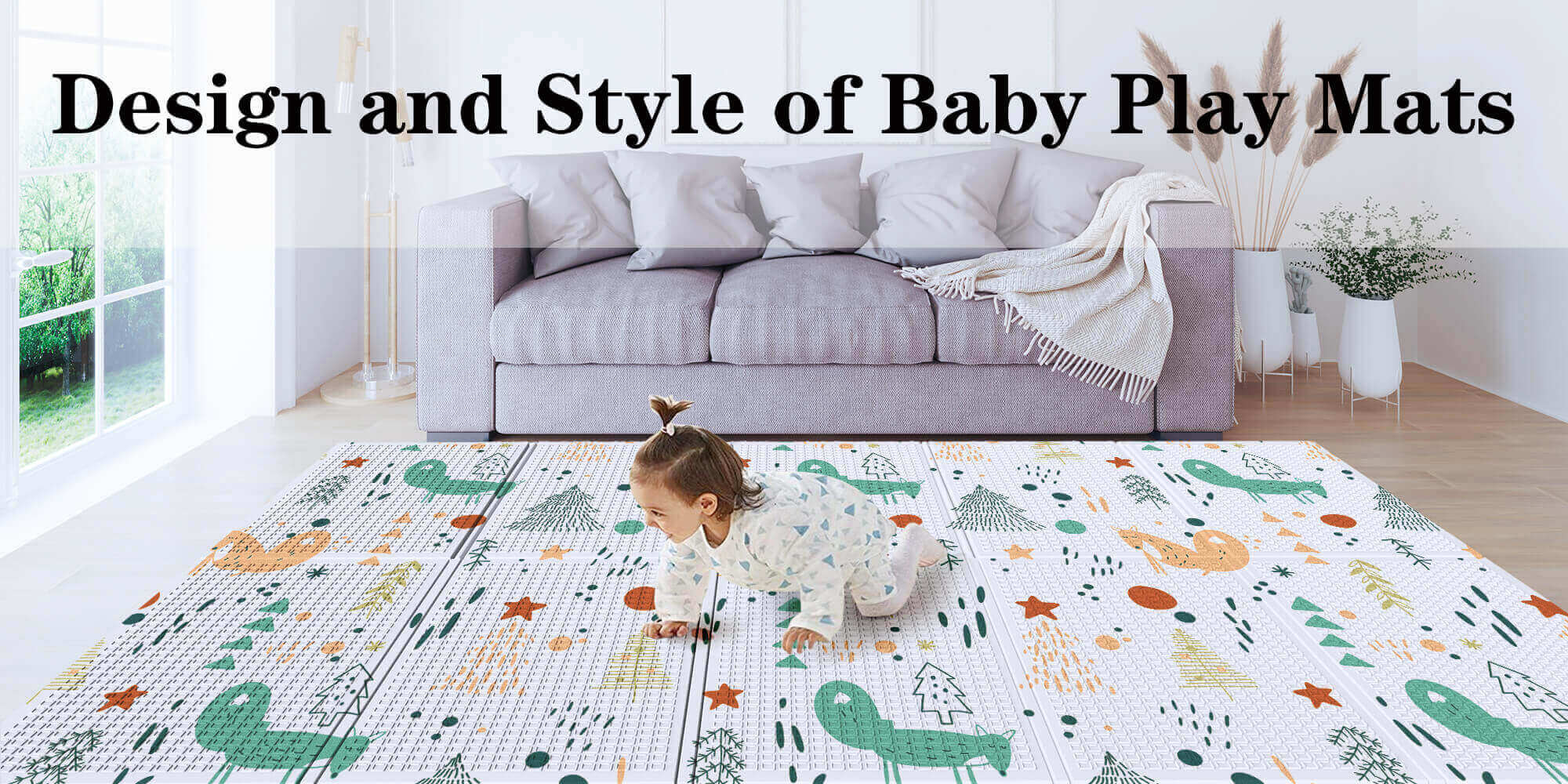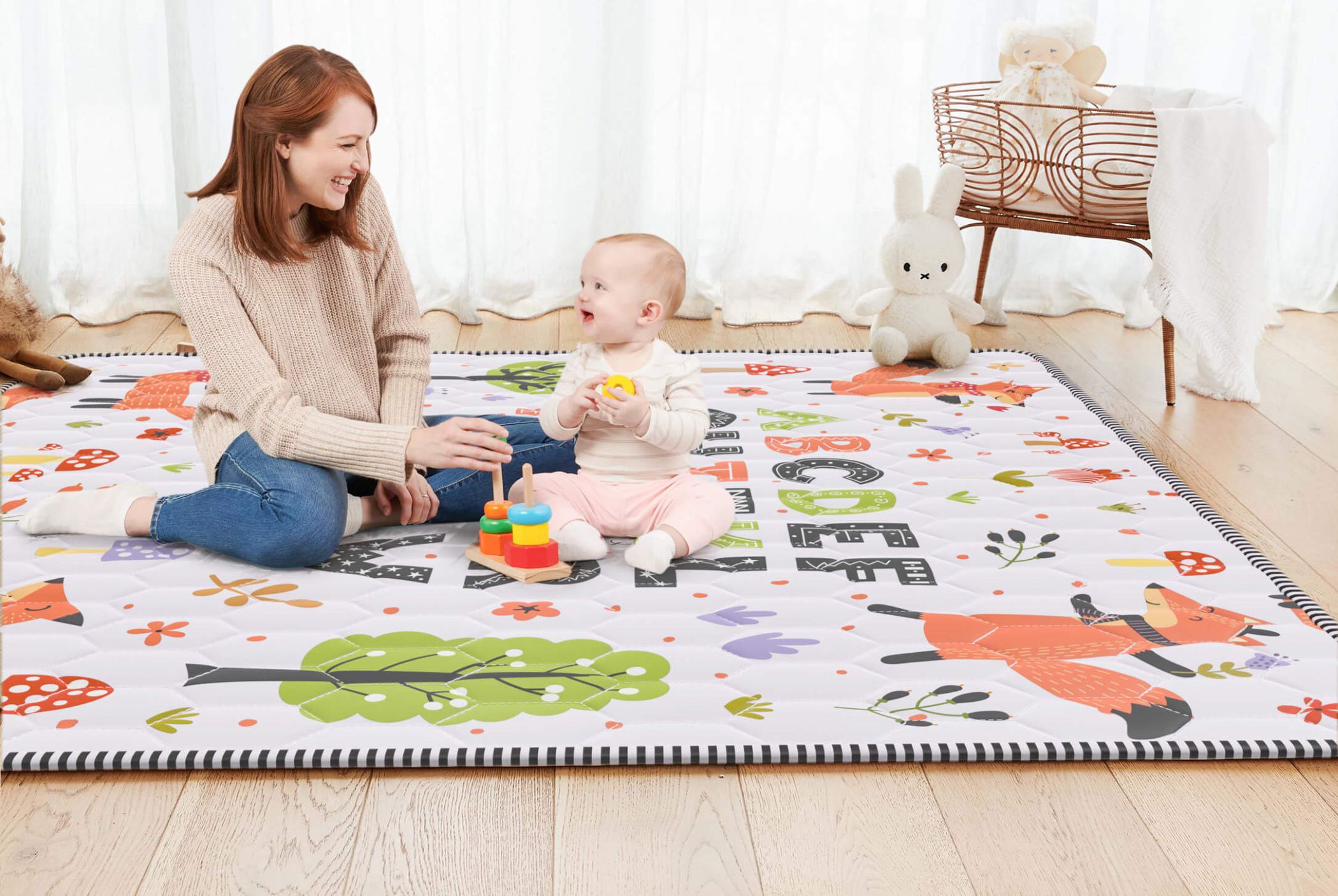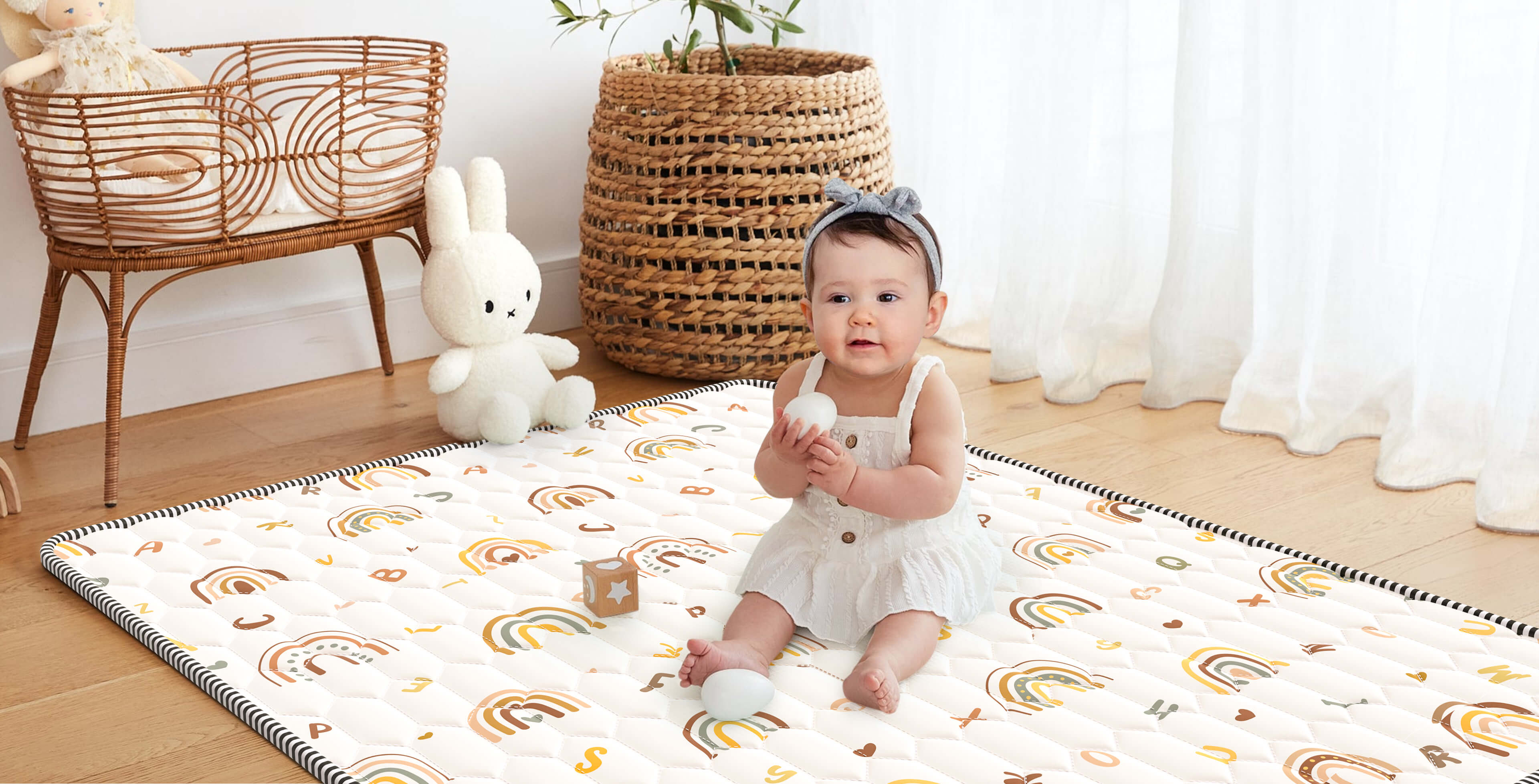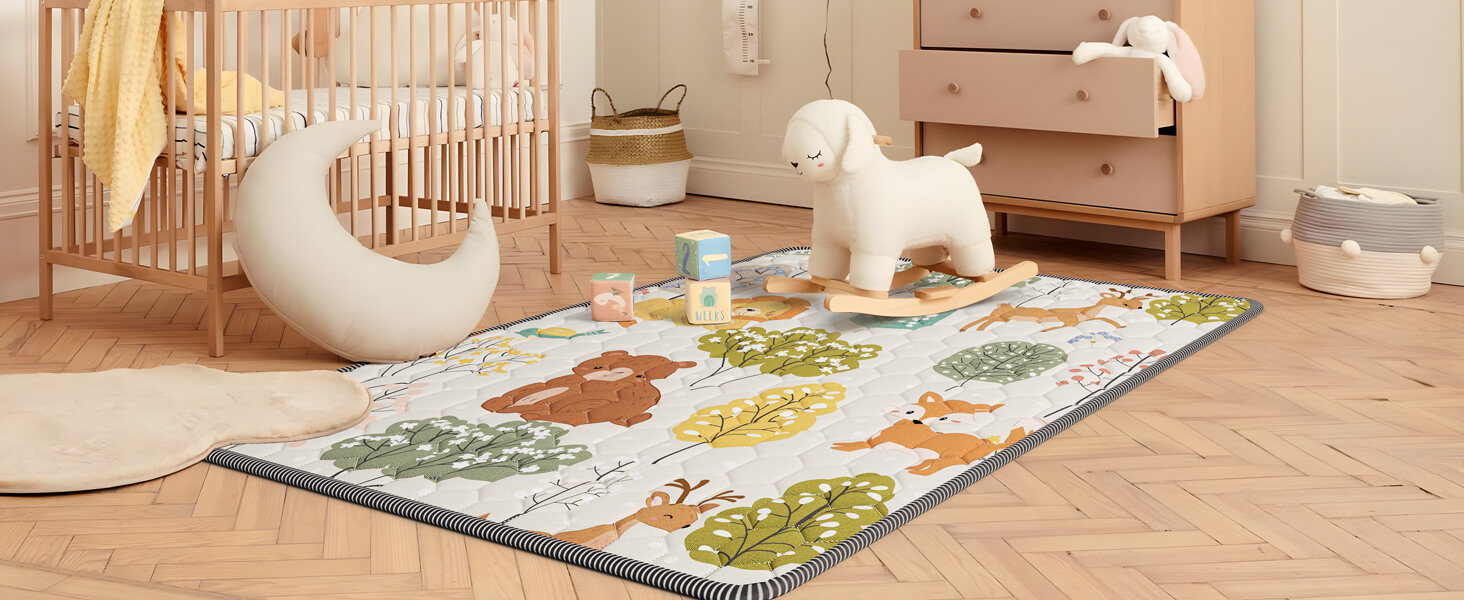
- Home
- Baby Play Mats
- Essential Tips for Maintaining Your Baby Play Mat Safely
Essential Tips for Maintaining Your Baby Play Mat Safely

A baby play mat is more than just a place for your little one to explore, it’s a safe space where they can crawl, roll, and grow while interacting with their surroundings. However, with frequent use, play mats can become dirty and wear down over time. Proper maintenance is essential not only to extend the life of your baby’s play mat but also to ensure your child’s health and safety.
In this comprehensive guide, we’ll walk you through the step-by-step process of cleaning and maintaining your baby’s play mat, discuss different materials and how they affect cleaning methods, and provide useful tips for long-term care. Whether you’re a first-time parent or experienced, this guide will help you keep your baby’s play mat in top condition.
Why Proper Maintenance of a Baby Play Mat Matters
Before diving into the maintenance tips, let’s understand why it’s crucial to regularly clean and care for a baby play mat:
Health and Hygiene: Babies often spend a significant amount of time on the play mat, crawling and touching everything. A dirty mat can harbor bacteria, allergens, and dirt, which may expose your baby to infections.
Longevity: Regular care ensures that the play mat doesn’t degrade quickly due to stains, tears, or rough handling.
Safety: A well-maintained mat is safer as it prevents any wear and tear that could lead to choking hazards or skin irritations.
By maintaining your baby play mat properly, you create a healthier and safer environment for your child while maximizing your investment.
Understanding Baby Play Mat Materials

Not all baby play mats are made from the same materials, and this affects how they should be cleaned and maintained. Here’s an overview of the most common materials:
1. Foam Play Mats
Foam mats are popular due to their soft and cushiony feel, making them ideal for babies learning to crawl. They are typically made from EVA (ethylene-vinyl acetate) or PE (polyethylene) foam.
Pros: Soft and comfortable, provides shock absorption, and easy to store.
Cons: Can absorb moisture and may become breeding grounds for bacteria if not cleaned properly.
2. Rubber Play Mats
Rubber mats are durable, waterproof, and often eco-friendly. They are perfect for playrooms or spaces where spills are common.
Pros: Waterproof, non-slip, and highly durable.
Cons: Can be harder and less comfortable than foam mats.
3. Fabric Play Mats
Fabric play mats are often made from cotton, polyester, or blends. These are comfortable and come in various designs, but they require more frequent cleaning.
Pros: Soft and cozy, machine washable.
Cons: Less durable and may stain easily.
4. Plastic Play Mats
Plastic mats are usually made from PVC or other waterproof materials. They are easy to clean and ideal for outdoor use.
Pros: Waterproof, easy to clean, affordable.
Cons: Can be less comfortable for prolonged use and may not be as eco-friendly.
Each type of material requires a unique approach to cleaning and maintenance, as outlined below.
Step-by-Step Guide to Cleaning Your Baby Play Mat
Keeping your baby’s play mat clean is crucial for preventing germs, stains, and wear. Follow these steps to ensure a thorough clean:
1. Daily Spot Cleaning: Essential for Immediate Messes
Babies tend to spill food, drool, or have diaper leaks on their play mats, so quick attention to these spots can prevent long-term staining and bacterial growth. Daily spot cleaning ensures that minor spills don’t turn into stubborn stains or cause odors. Here’s how to effectively clean daily messes, depending on the type of play mat:
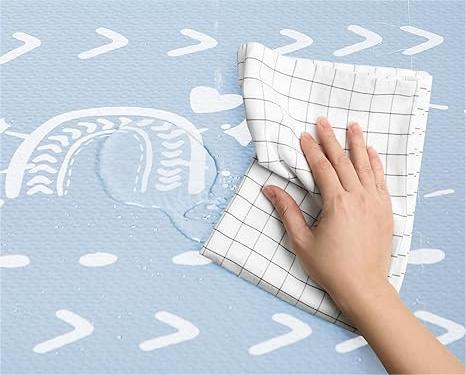
Foam Play Mats
Cleaning Process: Use a soft, damp cloth or sponge and a mild baby-safe soap to gently clean the affected area. Avoid soaking the mat in water, as foam absorbs moisture easily, which could lead to mold growth. If needed, use a gentle circular motion to lift any spills. Once cleaned, dry the mat with a towel or let it air-dry before use.
Caution: Avoid using abrasive brushes, which may damage the surface of the foam.
Rubber Play Mats
Cleaning Process: Use a clean cloth or sponge dipped in a solution of water and mild detergent. Gently wipe the spill or mess, then rinse with a damp cloth to remove soap residue. Rubber mats dry quickly, so you can towel them off or let them air-dry for a short time.
Caution: Ensure the cleaning solution does not leave a slippery residue, especially on non-slip surfaces.
Fabric Play Mats
Cleaning Process: Blot the spill immediately with a clean, dry cloth to absorb excess liquid. Then, use a damp cloth with a mild detergent to gently clean the stain. Avoid scrubbing too hard, as this could damage the fibers. If the fabric mat is machine-washable, consult the care label for instructions, or move to deep cleaning for more stubborn spots.
Caution: Never oversaturate the fabric with water, as it may take longer to dry and develop odors.
Plastic Play Mats
Cleaning Process: Simply wipe the spill with a disinfectant wipe or a cloth dipped in soapy water. Plastic mats can handle stronger cleaning agents, but for daily cleaning, stick to baby-safe detergents.
Caution: Ensure the mat is completely dry before the baby uses it again, as a wet plastic mat may become slippery.
2. Deep Cleaning: Weekly or Bi-Weekly Thorough Cleansing
In addition to daily maintenance, it’s important to perform a deep cleaning to remove accumulated dirt, bacteria, and allergens. Deep cleaning should be done every week or two, depending on the frequency of use and the material of your baby’s play mat.
Foam Play Mats
Cleaning Process:
Disassemble (if applicable): If your foam mat comes in interlocking pieces or tiles, disassemble it for easier cleaning.
Clean with Mild Detergent: Use a bucket of lukewarm water mixed with a mild, non-toxic detergent. Dampen a soft cloth or sponge and wipe down each piece of the mat individually. Make sure to clean both sides of each tile.
Remove Stubborn Stains: For more persistent stains, use a solution of white vinegar and water (1:4 ratio). Foam mats can sometimes develop a residue from detergents, so ensure that you rinse each piece thoroughly with water.
Dry Completely: Lay the tiles flat or prop them up to air-dry fully. Foam mats must be completely dry before reassembling to avoid mold or mildew growth.
Caution: Do not submerge foam tiles in water or use excessive moisture.
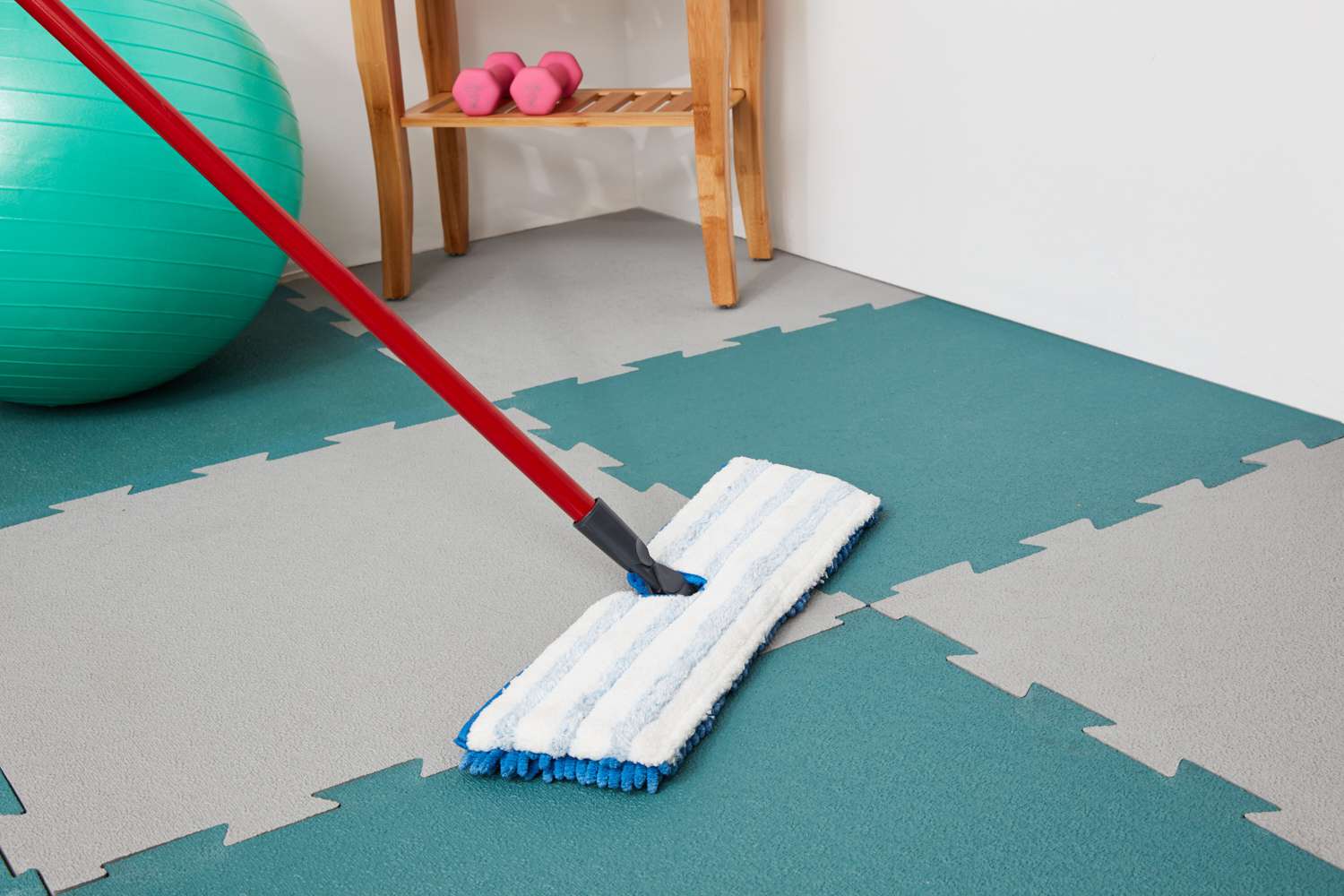
Rubber Play Mats
Cleaning Process:
Wipe with Soap and Water: Fill a bucket with a mixture of warm water and mild soap. Use a soft sponge or mop to wipe the surface of the mat thoroughly.
Rinse and Disinfect: After cleaning, use a clean cloth soaked in water to rinse off any soap residue. For added hygiene, spray the mat with a baby-safe disinfectant or a mixture of water and vinegar.
Dry: Let the rubber mat air-dry completely, or wipe it dry with a clean towel.
Caution: Avoid using harsh chemicals or bleach, as they can degrade the rubber material over time.

Fabric Play Mats
Cleaning Process:
Machine Wash (if applicable): Check the care label on your mat. Most fabric mats can be machine washed. Use a gentle cycle with cold water and mild detergent. Avoid fabric softeners, which can leave a residue.
Hand Wash for Non-Machine Mats: For non-machine washable mats, use a fabric cleaner or mild soap and water. Gently scrub the fabric with a soft-bristled brush to lift any deep-seated dirt.
Dry: Air-dry the mat completely. Never use a dryer, as high heat can shrink or damage the fabric.
Caution: Avoid using bleach or ammonia, which can weaken the fabric and pose a risk to your baby’s sensitive skin.
Plastic Play Mats
Cleaning Process:
Clean with Soapy Water: Wipe the mat down with a cloth or sponge soaked in warm soapy water. Scrub gently to remove any sticky or greasy residue.
Disinfect: For a deeper clean, use a disinfectant wipe or a diluted bleach solution (1 tablespoon of bleach per gallon of water) to sanitize the surface. Rinse the mat thoroughly after disinfecting.
Dry Completely: Let the plastic mat air-dry or wipe it dry with a clean towel to prevent water spots or slippery surfaces.
Caution: Ensure that all cleaning agents are thoroughly rinsed off to avoid any residue that could cause skin irritation.
3. Disinfecting: Ensuring a Germ-Free Play Space
In addition to regular cleaning, disinfecting your baby’s play mat is essential, especially if your baby has been sick or if the mat is shared among multiple children. Disinfection ensures that germs, bacteria, and viruses are eliminated.
Foam and Rubber Mats
Use a baby-safe disinfectant spray or a solution of water and white vinegar to wipe down the entire surface of the mat. Foam mats should be disinfected with minimal moisture to avoid water absorption. Always ensure the mat is fully dry before allowing your baby to use it.
Fabric Mats
After cleaning, spray the mat with a fabric-safe disinfectant. Ensure that the disinfectant is baby-friendly and free from harsh chemicals.
Plastic Mats
Use a disinfectant wipe or a diluted bleach solution. Wipe the entire surface, making sure to rinse it thoroughly with water afterward to avoid any chemical residue. Let the mat air-dry completely before use.
4. Drying and Airing Out: Preventing Moisture Buildup
One of the most important steps in maintaining your baby’s play mat is ensuring it is completely dry after cleaning. Moisture trapped in foam or fabric mats can lead to mold and mildew growth, which poses health risks.
Foam Mats: After cleaning, let the pieces air-dry for several hours in a well-ventilated area. Do not store foam mats when they are damp, as this can cause moisture buildup inside the material.
Rubber and Plastic Mats: These mats can be towel-dried or air-dried quickly. Make sure no water is left on the surface to prevent slipperiness.
Fabric Mats: Always air-dry fabric mats, avoiding the use of dryers. Lay the mat flat or hang it up to ensure even drying.
5. Storing Your Baby Play Mat
Once your baby play mat is clean and dry, proper storage can help prolong its lifespan.
Foam and Fabric Mats: Store mats in a cool, dry place to avoid exposure to moisture and direct sunlight. Fold or roll the mat, depending on its structure, and store it in a breathable bag or container.
Rubber and Plastic Mats: Since these are more durable, they can be rolled up and stored in a closet or under furniture. Ensure the storage area is clean to avoid re-contaminating the mat.
Preventing Damage to Your Baby Play Mat
Proper care also involves preventive measures to ensure the mat remains in good condition.
1. Avoid Sharp Objects
Avoid placing toys with sharp edges on the mat, as these can puncture or tear the surface, especially in foam and plastic mats.
2. Protect from Sunlight
Direct sunlight can cause the colors of your play mat to fade over time, especially with fabric and rubber mats. Keep the mat in a shaded area to preserve its appearance.
3. Proper Storage
If your play mat is foldable or comes in tiles, store it properly when not in use. Ensure it is completely dry before folding to prevent mold growth.
4. Use a Rug Pad or Carpet Underneath
For foam or fabric mats, consider placing a non-slip rug pad underneath to prevent the mat from moving around and reduce wear.
Addressing Common Issues with Baby Play Mats
Even with regular maintenance, you may encounter some common problems with baby play mats. Here’s how to address them:
1. Foul Odors
If the play mat starts to emit an unpleasant odor, it could be due to bacteria buildup, especially in foam and fabric mats. In this case:
Solution: Wash or wipe the mat thoroughly with a vinegar-water solution and let it air out. For fabric mats, ensure they dry completely before use.
2. Tears or Punctures
Over time, foam and plastic mats may develop small tears or punctures.
Solution: Use a patch kit for minor repairs. For significant damage, it may be best to replace the affected tile (for foam mats) or the entire mat if the damage is extensive.
3. Stubborn Stains
Sometimes, food or drink spills can leave stains that are difficult to remove, especially on fabric mats.
Solution: For fabric mats, try using a stain remover or pre-treating the stain before machine washing. For foam or plastic mats, a gentle scrubbing with baking soda can help lift the stain.
Best Practices for Long-Term Care
In addition to regular cleaning, following these best practices can extend the life of your baby’s play mat:
1. Rotate the Mat
If you notice one side of the mat is getting more wear, rotate it regularly to ensure even usage and prevent localized damage.
2. Use Baby-Safe Cleaning Products
Always choose non-toxic, baby-safe cleaning products to prevent exposure to harmful chemicals.
3. Inspect Regularly
Regularly inspect your mat for signs of wear, such as tears, holes, or loose parts that could become choking hazards. Replace the mat if it shows significant signs of wear.
4. Avoid Harsh Cleaning Methods
Avoid using bleach, ammonia, or strong chemicals that could damage the material of the play mat or cause skin irritation for your baby.
Final Thoughts
Maintaining your baby play mat is essential to ensuring it remains a safe, hygienic, and durable place for your baby to play. By following the steps outlined in this guide, you can extend the lifespan of your mat, protect your baby’s health, and provide a comfortable, clean space for your little one to explore.
Remember, regular cleaning and preventive care go a long way in keeping your baby’s play mat in top condition. Make it part of your routine, and you’ll enjoy the peace of mind that comes with knowing your baby is playing in a clean and safe environment.

